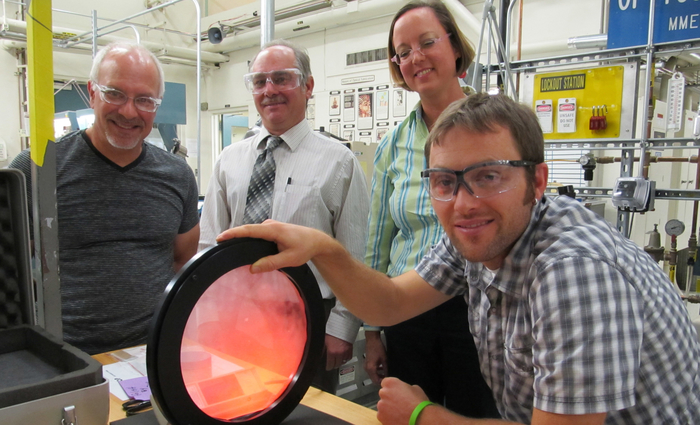Nerine Cherepy selected as IEEE senior member
 (Download Image)
Pictured from left: Peter Thelin, optician; Stephen Payne, Global Security N program leader for radiation detection materials; Nerine Cherepy, Institute of Electrical and Electronics Engineers senior member; and Zachary Seeley, ceramicist, holding an 11.5-inch-diameter transparent ceramic scintillator fabricated for the Weapons and Complex Integration Enhanced Surveillance Campaign.
(Download Image)
Pictured from left: Peter Thelin, optician; Stephen Payne, Global Security N program leader for radiation detection materials; Nerine Cherepy, Institute of Electrical and Electronics Engineers senior member; and Zachary Seeley, ceramicist, holding an 11.5-inch-diameter transparent ceramic scintillator fabricated for the Weapons and Complex Integration Enhanced Surveillance Campaign.
Livermore scientist Nerine Cherepy has been selected as a senior member of the Institute of Electrical and Electronics Engineers (IEEE).
Cherepy, who joined the Laboratory in 1998, has contributed to a variety of programs at Livermore, including the joint invention of a novel direct carbon fuel cell for the energy program, the establishment of the cleaning protocol used for aluminum parts in the National Ignition Facility and the development of chemoselective colorimetric sensors for the Global Security (GS) Principal Directorate. Her most notable contributions have been to the field of radiation detection materials and detectors.
"I am honored to have been nominated by my fellow IEEE senior members, at LLNL and outside the Lab, and then to have been selected by the council to be elevated to senior membership," Cherepy said. "I have had the good fortune to have been mentored by several senior scientists and engineers at LLNL and to have the chance to participate in and lead a variety of challenging multidisciplinary technical projects with successful outcomes in radiation detector materials and nuclear instrumentation".
Cherepy led various research teams on projects supported by Livermore's Laboratory Directed Research and Development Program, including research concerning the direct conversion of fossil fuels into electricity, photochromic radiation dosimetry and remote sensing of alpha and beta particle sources.
Her efforts with IEEE includes serving twice as the topic convener at the annual IEEE Nuclear Science Symposium and co-authoring 26 articles in the journal IEEE Transactions on Nuclear Science.
"The LLNL environment is particularly conducive to teamwork, and my growth as a scientist is due to the constantly evolving opportunities to work alongside chemists, physicists, materials scientists, nuclear, electrical and mechanical engineers to solve problems that always seem to require a combination of exploratory basic science and pragmatic engineering," Cherepy said. "I appreciate the trust placed in us by our DHS and DOE sponsors, and the support of LLNL management and infrastructure, without which none of these new detector materials or detectors could have been developed."
Cherepy and her team discovered two new scintillator materials with breakthrough performance for gamma-ray spectroscopy. Her team's current research includes the development of a transparent ceramic lutetium-oxide-based scintillator and the creation of new plastic scintillators incorporating bismuth for gamma detection, the first scintillating plastic capable of gamma spectroscopy.
As the holder of 11 patents, Cherepy has been honored by the Department of Homeland Security with an award for superior performance in scintillator discovery. She is an inventor on two R&D 100 Awards, has been named a Department of Energy Outstanding Mentor and has received a Nano 50 Award in addition to several internal team awards from GS and the Physical and Life Sciences Directorate.
IEEE is the world's largest professional association dedicated to advancing technological innovation and excellence. Only 7 percent of IEEE members attain the level of senior member, which requires 10-plus years of professional experience and significant contributions, achievements, publications and course development or technical direction in IEEE-designated fields.
Contact
 Anne M. Stark
Anne M. Stark
[email protected]
(925) 422-9799
Related Links
IEEETags
EngineeringIEEE
Featured Articles







